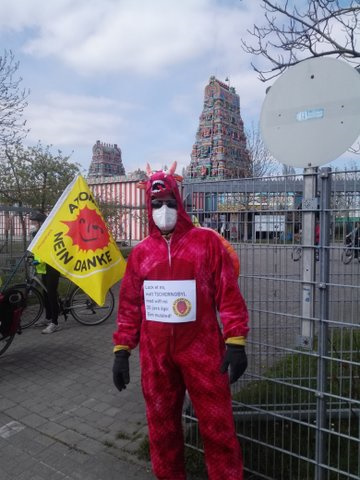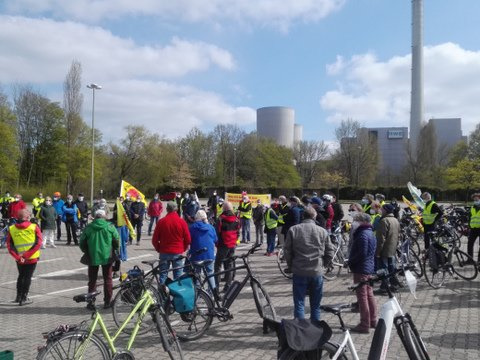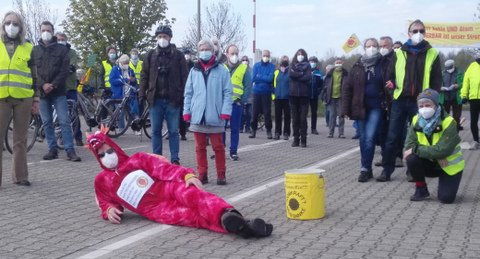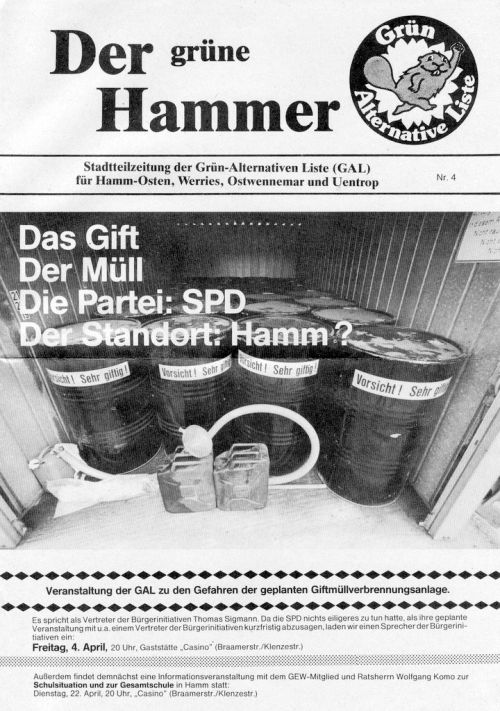Newsletter XIX 2021 | |
April 25-27
***
| 2024 | 2023 | 2022 | 2021 | |
| 2020 | 2019 | 2018 | 2017 | 2016 |
| 2015 | 2014 | 2013 | 2012 | 2011 |
| Current news+ | Background knowledge |
***
April 27, 2021 - Climate Minister publishes booklet on "Fairy Tales of the Nuclear Lobby"
*
Sh ... caught!
April 27, 2021 - Altmaier apologizes for calculation errors in wind power noise exposure
*
April 27, 2021 - 35 years of Chernobyl - Lessons from the reactor catastrophe
35 years after the reactor disaster in Chernobyl, Matthias Eickhoff recalls what happened at that time and draws a balance sheet for (energy) politics as well as for the anti-nuclear movement in Germany. (GWR-Red.)
On the night of April 25th to 26th, 1986, the unthinkable occurred in the Soviet Chernobyl nuclear power plant: Reactor 4 got out of control during an experiment and exploded. A GAU - the “Largest Accident Accident” - turned into a super-GAU overnight. The consequences were and are catastrophic to this day. At first, the Soviet party leadership in Kiev and central Moscow criminally underestimated the effects and ordered absolute secrecy. The people in Western Europe were only alerted a few days later by the measurement of increased radioactivity in Sweden ...
The international consequences
The worst-case scenario had major international consequences: In the Soviet Union, it was one of the coffin nails in the communist era. Party and government leader Mikhail Gorbachev initially remained silent, as did the entire government. It was only later, under the pressure of events, that he introduced his now famous approaches of “perestroika” (politics of social openness) and “glasnost” (politics of transparency). These opened the hermetically sealed Soviet society and ultimately led to the collapse of the Soviet Union.
The consequences were also dramatic in the rest of Europe, but were perceived very differently. In Eastern Europe attempts were made to keep Chernobyl secret in its entirety. Officially, the reactor disaster hardly took place in countries like France either. That is certainly one reason why nuclear power has not really been questioned in France, but also in the Czech Republic, Slovakia and Hungary. By completely hiding Chernobyl, the obvious risks of nuclear power never really penetrated social consciousness ...
*
April 27, 2021 - Contagious Solar Cells
*
April 27, 2021 - Al Gore: We are living at the dawn of a sustainability revolution
*
April 26, 2021 - Myths about Chernobyl in the fact check
*
April 26, 2021 - 35 years after Chernobyl - the Europe-wide nuclear phase-out is overdue
*
April 26, 2021 - Record global arms spending: guns, more guns
*
April 26, 2021 - Ukrainian nuclear power in deadlock
*
April 26, 2021 - 35 years after Chernobyl: Nuclear power cannot be tamed
*
April 25, 2021 - For the 35th Chernobyl anniversary: Successful bike ride to the THTR!

One of the largest anti-nuclear demonstrations in recent years took place in Hamm on Sunday one day before the Chernobyl anniversary. The citizens' initiative for environmental protection in Hamm and Hamm against Atom organized a bicycle tour to the thorium high-temperature reactor (THTR) in Uentrop. The meeting point for the cyclists was Willy-Brandt-Platz at Hammer Hauptbahnhof. Then we drove towards Uentrop to meet friends from Beckum and Ahlen at the Hindu temple and to drive together to the disused THTR.
 The more than 80 cyclists not only commemorated the Chernobyl disaster in Russia in 1986, but also recalled the simultaneous incident in the THTR, where radioactive spherical fuel elements had jammed in the pipe system of the reactor. In the attempt to blow them free, they were destroyed and partly transported out as dust, which led to increased radiation exposure in the area. In her speech, Benigna Grüneberg vividly recalled that at that time it was advised against letting children play in the sand, restaurateurs had to destroy contaminated food and farmers could not let their animals graze.
The more than 80 cyclists not only commemorated the Chernobyl disaster in Russia in 1986, but also recalled the simultaneous incident in the THTR, where radioactive spherical fuel elements had jammed in the pipe system of the reactor. In the attempt to blow them free, they were destroyed and partly transported out as dust, which led to increased radiation exposure in the area. In her speech, Benigna Grüneberg vividly recalled that at that time it was advised against letting children play in the sand, restaurateurs had to destroy contaminated food and farmers could not let their animals graze.
 For BI, Werner Jäger-Kersting emphasized environmental protection at the numerous actions, large-scale demonstrations and blockades that we carried out between 1986 and 1989 in order to finally shut down this bankruptcy reactor. Many of the participants from back then were back on the pitch after 35 years and remembered the horror, but also the success they had fought for, and passed these experiences on to the younger ones. The anti-nuclear movement was still surprisingly vital that day at THTR!
For BI, Werner Jäger-Kersting emphasized environmental protection at the numerous actions, large-scale demonstrations and blockades that we carried out between 1986 and 1989 in order to finally shut down this bankruptcy reactor. Many of the participants from back then were back on the pitch after 35 years and remembered the horror, but also the success they had fought for, and passed these experiences on to the younger ones. The anti-nuclear movement was still surprisingly vital that day at THTR!
*
Violence against activists worldwide
April 25, 2021 - "Companies hire killers to kill environmentalists"
*
April 25, 2021 - Litschauer: Chernobyl as a reminder - nuclear energy is not worth the risk
*
Weltspiegel - Chernobyl area
April 25, 2021 - Living with the radiation - and the fear
Top | |
| Current news+ | Background knowledge |
***
Current news+
April 25, 2021 - MiK gears up for important battles to come
While researching MiK - military-industrial complex, nuclear industry division, nuclear lobby subdivision - I found several interesting articles that indicate that MiK is feverishly working on a fundamental change in strategy in communications in the election year 2021.
1. Instead of appearing exclusively as a homogeneous block of well-known, clearly interest-driven and apparently highly official, powerful institutions (IAEA, WNA, WANO, German Atomic Forum, etc.), they now also appear as a colorful group of many small, newly founded NGOs that should give the appearance of a broad citizen movement. The personal overlaps, however, clarify the picture, the members of the new NGOs, like the members of the well-known lobby organizations, are salaried employees, ex-employees and / or their relatives, beneficiaries of the nuclear industry.
2. Communication scientists and advertising professionals are hired to feed the wolf the chalk. References to dangers and risks of the uranium industry as well as all hard facts are deleted from all speeches; instead, the undeniable need for nuclear power plants to avert the climate crisis is being asserted very aggressively and loudly. There is also a lot of talk about medical progress and all the as yet unforeseeable achievements that atomic research will bring us in the future. All of these rather vague assumptions and announcements are presented as irrefutable facts. And again and again the unobtrusive hint with the fence post that every clear-thinking person must recognize this ...
Anyone who dares to contradict this cannot be completely in their right mind.
The nuclear industry's fear of losing power is quite understandable, because the development in the field of renewable energies is breathtaking and it is obvious that renewables will sooner rather than later displace nuclear energy from the energy market.
Nuclear power plants are only needed for atomic bombs.
Up to 35 years ago, more than 70 of the almost 200 countries worldwide were ready to invest in nuclear energy. Today 56 countries still operate active research reactors, and of these 56 only 32 have commercial nuclear power plants on the grid. Some of these countries have already announced their exit from the uranium industry. The MiK has to hurry, if Germany pulls out in 1 ½ years, a very important stone will fall out of their crown. Time is of the essence, when the first stone falls, as with the domino effect, the game is over (chain reaction). The end of atomic energy is accelerating with every member of the atomic community that "goes off the flag".
The current situation is as follows: the carrot and stick for everyone
Depending on the needs, traditional methods of black pedagogy are used in a modernized form.
MiK's propaganda department paints beautiful, fantastically colorful pictures of a rosy nuclear future for the dear children.
The parents, grandparents and the not so dear children are presented with different visions: A gray, zombie-ridden world without law enforcement, military, (nuclear) industry, jobs and security, so "no future" for the following generations.
Meanwhile, high-ranking military officials, politicians, civil servants, journalists and other employees - beneficiaries of the MiK system - are increasing the pressure on those who think differently, bar by bar; of course without a receipt and certainly without leaving any traces of evidence.
Lying and cheating? Of course, it works!
Uranium is being hailed as the raw material of the future and at the same time uranium mines are being closed because the price has fallen below the value that would cover the operation of the mines. In January 2011, the uranium price was 60 US dollars, in January 2021 it is 30 US dollars.
Nuclear power is being touted as the means to tackle the climate crisis, although everyone knows that this is not true. No black eye stays dry when there is an undisguised, hard power play being played at the EU level.
There will be a lot of votes this year
So again everyone, especially the ugliest birds of the political caste, is professionally pimped up. Most of the time, a little style advice and Photoshop are enough, but if necessary, basic renovation with a scalpel is also used. With the new pictures in all media, the wolves are then sent into the election campaign as hot Little Red Riding Hoods.
MiK has already raised ample funds for all of these measures in the past. And the current battle over atomic energy is about access to tens of billions more tax dollars for the next 50 years.
But do not worry, only when all of this is no longer enough, MiK will deploy the troops ...
Top | |
| Current news+ | Background knowledge |
***
Background knowledge
**
reaktorpleite.de
Map of the nuclear world:
Who pays for the next disaster?
The German version of this world map:
https://www.google.com/maps/d/viewer?mid=1fCmKdqlqSCNPo3We1TWZexPjgNDQOaLD
**
The search in the reaktorpleite.de with the search term
| Super disaster |
brought the following results, among others:
April 25, 2017 - Accident in a nuclear power plant near the border Nobody is liable for the super meltdown
Jürgen Döschner / tagesschau.de
*
When people talk about nuclear accidents, they mostly talk about Fukushima 2011 and Chernobyl 1986. Even the 1979 Harrisburg accident is somehow not really remembered, although the radioactivity release in Harrisburg was more than twice as high as in Fukushima. Then there is Majak and Windscale / Sellafield, both in 1957, etc. ...
NAMS - Nuclear Accident Magnitude Scale
assesses the severity of a nuclear accident based on the release of radioactivity (sorted by Release TBq), the costs in millions of US dollars relate to the dollar rate of 2013 ...
The dirtiest dozen:
| Date: | Lease | Release TBq Terabecquerels | NAMS | INES | Cost (mil. US $) |
| April / 26/1986 | Chernobyl, Ukraine | 5,2 Million | 8 | 7 | 32078.5 |
| March / 28/1979 | Three Milles Island, United States | 3,7 Million | 7,9 | 5 | 2773.4 |
| March / 11/2011 | Fukushima, Japan | 1,59 Million | 7,5 | 7 | 166088.7 |
| Sept/29/1957 | Mayak, Kyshtym, USSR | 1,0 Million | 7,3 | 6 | 2351.4 |
| Sept/11/1957 | Rocky Flats, United States | 7800 | 2,3 | 5 | 8189.0 |
| April / 01/1967 | Mayak, USSR | 5600 | 5 | 5 | 0 |
| April / 06/1993 | Seversk, Tomsk 7, Russia | 3500 | 4,8 | 4 | 51.4 |
| Oct./07/1957 | Windscale, UK | 1786 | 4,6 | 5 | 89.9 |
| March / 25/1955 | Sellafield, UK | 1000 | 4,3 | 4 | 4400 |
| May / 01/1968 | Sellafield, UK | 550 | 4 | 4 | 1900 |
| June / 19/1961 | Sellafield, UK | 540 | 4 | 3 | 800 |
| April / 10/2003 | Paks, Hungary | 360 | 3,9 | 3 | 42.8 |
Download the entire list:
Nams + Ines - Nuclear Power Accidents (PDF)
**
Wikipedia
Super Gau - beyond design basis accidents
Over-design-basis accidents are accidents in which higher loads occur than in the design basis accident defined above. In the event of a release of radioactivity beyond the legally stipulated limit values, the scope of the design basis accident is by definition exceeded; it is an over design basis accident.
Strictly speaking, an accident from INES level 5 meets this requirement. A beyond design basis accident with INES level 5 occurred, for example, in 1957 in the British nuclear complex Sellafield (formerly Windscale, see Windscale brand) and also in the American nuclear power plant Three Mile Island (1979). However, it is customary in politics and the press to describe serious and catastrophic accidents as “super-GAU” (INES 6 and INES 7). The best-known examples of a worst-case scenario are the disasters in Fukushima (2011) and Chernobyl (1986). In some cases, the site and its surroundings became uninhabitable for a long time, for example the city of Prypiat, four kilometers from the Chernobyl nuclear power plant.
Measures for the case of beyond design basis accidents are specified in the emergency manual of the respective power plant. Possible beyond design basis accidents are also included in the disaster control plans of the authorities. Stress tests can also be used to determine the safety reserves that are still available in the event of cross-design incidents in order to reduce any impact on the environment.
As a rule, the investment in the affected nuclear facility is completely lost as a result of an beyond-design-basis incident. Costs for emergency measures, for the elimination of accidental damage (as far as possible) and economic costs (for example due to additional cancer diseases) can exceed the operating profits generated up to that point many times over. No insurance company insures these risks; the largest part is borne by the states, i.e. their taxpayers.
**
AtomkraftwerkePlag
Other nuclear accidents and incidents
"History teaches all the time, but it does not find students."
(Ingeborg Bachman)
In addition to the disasters in Fukushima and Chernobyl, there were other nuclear accidents that led to major radioactive contamination, such as in Mayak or Tomsk, or incidents that did not end in a meltdown just because of fortunate circumstances. These events alone should be enough to demonstrate the dangers of using "peaceful" atomic energy.
According to a 2012 estimate, the accidents, along with the Chernobyl and Fukushima disasters, cost $ 471 billion ...
**
Further to: Newspaper article 2021
***
Top | |
| Current news+ | Background knowledge |
For work on 'THTR circular', 'reaktorpleite.de' and 'Map of the nuclear world' we need up-to-date information, energetic, fresh comrades-in-arms under 100 (;-) and donations. If you can help, please send a message to: info@reaktorpleite.de
Donation appeal
- The THTR circular is published by the 'BI Environmental Protection Hamm' and is financed by donations.
- The THTR circular has meanwhile become a much-noticed information medium. However, there are ongoing costs due to the expansion of the website and the printing of additional information sheets.
- The THTR circular researches and reports in detail. In order for us to be able to do that, we depend on donations. We are happy about every donation!
Donations account: BI Umweltschutz Hamm
Usage: THTR Rundbrief
IBAN: DE31 4105 0095 0000 0394 79
BIC: WELADED1HAM
***



